Related Research Articles

East Grand Rapids is a city in Kent County in the U.S. state of Michigan. It is located in the Grand Rapids metropolitan area and is located on the shores of Reeds Lake. As of the 2010 census, the city population was 10,694.
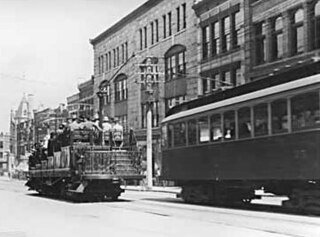
The British Columbia Electric Railway (BCER) was an historic railway which operated in southwestern British Columbia, Canada. Originally the parent company, and later a division, of BC Electric, the BCER assumed control of existing streetcar and interurban lines in southwestern British Columbia in 1897, and operated the electric railway systems in the region until the last interurban service was discontinued in 1958. During and after the streetcar era, BC Electric also ran bus and trolleybus systems in Greater Vancouver and bus service in Greater Victoria; these systems subsequently became part of BC Transit, and the routes in Greater Vancouver eventually came under the control of TransLink. Trolley buses still run in the City of Vancouver and one line extends into Burnaby.
M-1, commonly known as Woodward Avenue, is a north–south state trunkline highway in the Metro Detroit area of the US state of Michigan. The highway, called "Detroit's Main Street", runs from Detroit north-northwesterly to Pontiac. It is one of the five principal avenues of Detroit, along with Michigan, Grand River, Gratiot, and Jefferson avenues. These streets were platted in 1805 by Judge Augustus B. Woodward, namesake to Woodward Avenue. The Federal Highway Administration (FHWA) has listed the highway as the Automotive Heritage Trail, an All-American Road in the National Scenic Byways Program. It has also been designated a Pure Michigan Byway by the Michigan Department of Transportation (MDOT), and was also included in the MotorCities National Heritage Area designated by the US Congress in 1998.
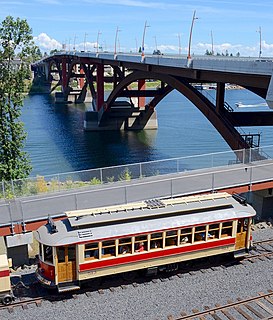
The Willamette Shore Trolley is a heritage railroad or heritage streetcar that operates along the west bank of the Willamette River between Portland and Lake Oswego in the U.S. state of Oregon. The right-of-way is owned by group of local-area governments who purchased it in 1988 in order to preserve it intact for possible rail transit use in the future. Streetcar excursion service began operating on a trial basis in 1987, lasting about three months, and regular operation on a long-term basis began in 1990. The Oregon Electric Railway Historical Society has been the line's operator since 1995.

A horsecar, horse-drawn tram, or (U.S.) horse-drawn streetcar, is an animal-powered tram or streetcar.

The F Market & Wharves line is one of several light rail lines in San Francisco, California. Unlike most other lines in the system, the F line runs as a heritage streetcar service, almost exclusively using historic equipment both from San Francisco's retired fleet as well as from cities around the world. While the F line is operated by the San Francisco Municipal Railway (Muni), its operation is supported by Market Street Railway, a nonprofit organization of streetcar enthusiasts which raises funds and helps to restore vintage streetcars.
The Interurban Transit Partnership operates a public transit system called The Rapid, which provides bus service to the Grand Rapids, Michigan metropolitan area and beyond. The Rapid was recognized in 2004 and 2013 by receipt from the American Public Transportation Association of an "Outstanding Public Transportation System Award".
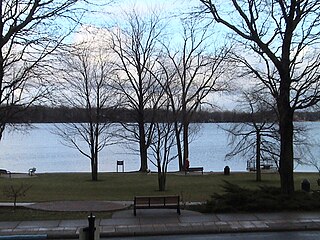
Reeds Lake is a fresh-water lake in the city of East Grand Rapids, Michigan, United States. Formerly the site of an early-20th-century amusement park and resort popular with residents of nearby Grand Rapids, it is adjacent to the suburb's modern-day city center, and serves as a symbol for the community. It is surrounded by private residences along most of its north, east, and south shores, and by public parks municipal facilities, and a few businesses on its west and northwest shores.

Streetcars were part of the public transit service in Kenosha, Wisconsin, in the first third of the 20th century and returned to this role in 2000.

The Fort Smith Trolley Museum is a streetcar and railroad museum in Fort Smith, in the U.S. state of Arkansas, which includes an operating heritage streetcar line. The museum opened in 1985, and operation of its streetcar line began in 1991. Four vehicles in its collection, a streetcar and three steam locomotives, are listed on the National Register of Historic Places (NRHP). The now approximately three-quarters-mile-long (1.2 km) streetcar line also passes four NRHP-listed sites, including the Fort Smith National Historic Site, the Fort Smith National Cemetery, the West Garrison Avenue Historic District and the 1907 Atkinson-Williams Warehouse Building, which now houses the Fort Smith Museum of History.

Streetcars or trolley(car)s were once the chief mode of public transit in hundreds of North American cities and towns. Most of the original urban streetcar systems were either dismantled in the mid-20th century or converted to other modes of operation, such as light rail. Today, only Toronto still operates a streetcar network essentially unchanged in layout and mode of operation.

Ramona Park was an amusement park located in the city of East Grand Rapids, Michigan between 1897 and 1955. The Park included a double track wooden roller coaster, a theater pavilion, a ridable miniature railway and boat livery.
The Detroit, Lansing and Northern Railroad (DL&N) is a defunct railroad which was formed on December 27, 1876 as a reorganization of the foreclosed Detroit, Lansing and Lake Michigan Rail Road. The segment of its main line from Detroit to Lansing became an important component of the Pere Marquette Railroad, organized in 1900, and is still in use by CSX.
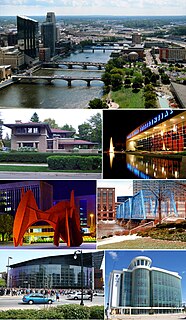
Grand Rapids is the second-largest city in Michigan and the county seat of Kent County. Situated along the Grand River approximately 30 miles (48 km) east of Lake Michigan, it is the economic and cultural hub of West Michigan, the fastest growing major city in Michigan, and one of the fastest growing cities in the Midwest. According to 2019 US Census Bureau estimates, the city had a population of 201,013, while the greater metropolitan area had a population of 1,077,370, and a combined statistical area population of 1,412,470.
The Ramona Branch was a railroad branch line in Kent County, Michigan. First placed in service in August, 1888, it ran 2.53 miles (4.07 km) starting from its connection at its western end with the Detroit, Lansing and Northern Railroad at Oakdale Park Station in southeast Grand Rapids, Michigan. It ran in a northeasterly direction to end at the popular resort Reeds Lake in East Grand Rapids, Michigan. It is a separate line from the Grand Rapids & Reeds Lake Railway line that connected to Ramona Park in the same area.

The Seattle Streetcar is a system of two modern streetcar lines operating in the city of Seattle, Washington. The South Lake Union line opened first in 2007 and was followed by the First Hill line in 2016. The two lines are unconnected, but share similar characteristics: frequent service, station amenities, and vehicles. Streetcars typically arrive every 10–15 minutes most of the day, except late at night. The streetcar lines are owned by the Seattle Department of Transportation and operated by King County Metro.

Streetcars in St. Louis, Missouri operated as part of the transportation network of St. Louis from the middle of the 19th century through the early 1960s. During the first forty years of the streetcar in the city, a variety of private companies operated several dozen lines; from the start of the 20th century, most of these companies consolidated into the St. Louis Public Service Company, which served both the city of St. Louis and neighboring St. Louis County, Missouri. Other private companies, such as those serving the Metro East region or St. Charles, Missouri, continued separate operations. Starting in the 1930s and continuing through the 1960s, St. Louis Public Service ended all streetcar service, while other regional operators also ended their services.

Transportation in metropolitan Detroit is provided by a system of transit services, airports, and an advanced network of freeways which interconnect the city of Detroit and the Detroit region. The Michigan Department of Transportation (MDOT) administers the region's network of major roads and freeways. The region offers mass transit with bus services provided jointly by the Detroit Department of Transportation (DDOT) and the Suburban Mobility Authority for Regional Transportation (SMART) through a cooperative service and fare agreement administered by the Regional Transit Authority (RTA). Cross border service between the downtown areas of Windsor and Detroit is provided by Transit Windsor via the Tunnel Bus. A monorail system, known as the People Mover, operates daily through a 2.94 mile (4.7 km) loop in the downtown area. A proposed SEMCOG Commuter Rail could link New Center, Dearborn, Detroit Metropolitan Airport, and Ann Arbor with access to DDOT and SMART buses. Amtrak's current passenger facility is north of downtown in the New Center area. Amtrak provides service to Detroit, operating its Wolverine service between Chicago, Illinois, and Pontiac. Greyhound Lines operates a station on Howard Street near Michigan Avenue. The city's dock and public terminal receives cruise ships on International Riverfront near the Renaissance Center which complements tourism in metropolitan Detroit.
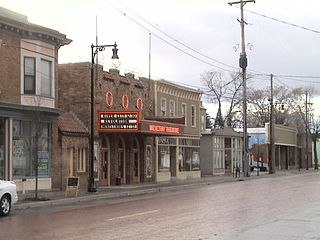
Wealthy Theatre is a historic movie theatre and performance center in Grand Rapids, Michigan. It is currently operated by the Grand Rapids Community Media Center, a non-profit corporation. Wealthy Theatre is a mixed-use facility, capable of hosting live music, film, theatre and dance.
The Nelson Electric Tramway is a heritage railway in Nelson, British Columbia, Canada. It uses two restored vintage streetcars which carry tourists along Nelson's waterfront and was the first operating heritage streetcar line in British Columbia. The service is seasonal, starting on the Easter weekend and ending on the Canadian Thanksgiving weekend each year. It is operated by the non-profit Nelson Electric Tramway Society (NETS). The line was opened on June 15, 1992, by the city's mayor; a second opening ceremony was held on July 1, 1992.
References
- ↑ Baxter, Albert (1974) [1891]. History of the city of Grand Rapids, Michigan : with an appendix--History of Lowell, Michigan (Google Books). Grand Rapids, Michigan: Grand Rapids Historical Society. p. 162. OCLC 2841595 . Retrieved 24 October 2009.
- ↑ Robert Samuel Gillespie (24 August 2006). "Horsin' Around Town" . Retrieved 24 October 2009.
- ↑ "Wealthy Street History & The Wealthy Theatre Historic District". Atomic Object. Atomic Object. Archived from the original on 2017-08-25. Retrieved 24 August 2017.